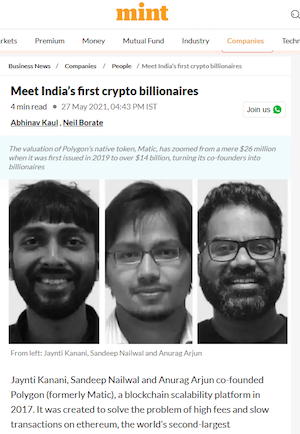Read Part 1 here: Slumdog billionaire: Incredible rags-to-riches tale of Polygon’s Sandeep Nailwal
Growing up in poverty in a Delhi ghetto with an alcoholic father and an illiterate mother, Sandeep Nailwal has always had a fire in his belly to achieve something better.
He wants to go big or go home — middling success is not an option.
“I am not doing something small,” he tells Magazine. “Okay, we build some network, and it has a token. It does well for one cycle and then fades into the dawn, and I make a few million dollars for myself and retire or whatever — this was not the plan.”
“We were very clear that we will build this, we will grow the community, and we’ll make it one of the biggest projects in the space.”
And that’s why, in his mind, Polygon — formerly Matic Network — is yet to truly succeed, despite nudging a $19-billion market cap at one point and joining the top 10 cryptocurrencies by market capitalization (it’s currently No. 13 with a $6-billion market cap).
“Being in the top 10, top 15 projects brings no satisfaction to me. It’s very clear in my mind that I want Polygon to have that kind of impact which Ethereum and Bitcoin have had. We have to go to the top three projects in the space. And that’s only when I would say that ‘OK Polygon has made it.’”
Part 1 of this feature told the story of Nailwal’s rise from grinding poverty to going all-in on Bitcoin with $15,000 he’d borrowed to fund his wedding and the difficult early days of Matic Network, where the threat of running out of funds was ever-present.
By mid-2019, Matic Network had raised $5 million in a Binance initial exchange offering to keep itself afloat and had launched the alpha version of its Ethereum layer-2 sidechain. But it was slowly becoming clear that the Plasma technology it was pursuing was not the answer the market was looking for.
Ideas around scaling had begun to change, and Plasma’s shortcomings (TLDR: complicated, better at transferring assets than running smart contracts) had seen it lose favor. Seeing which way the wind was blowing, the research-oriented Plasma Group decided to ditch the framework altogether in favor of building an Optimstic rollup and renamed the project “Optimism” in early 2020.
But the Matic Network white paper had outlined a Plasma-based solution with fraud proofs and a proof-of-stake checkpoint layer, and the team was determined to follow through…
Click Here to Read the Full Original Article at Cointelegraph.com News…
























